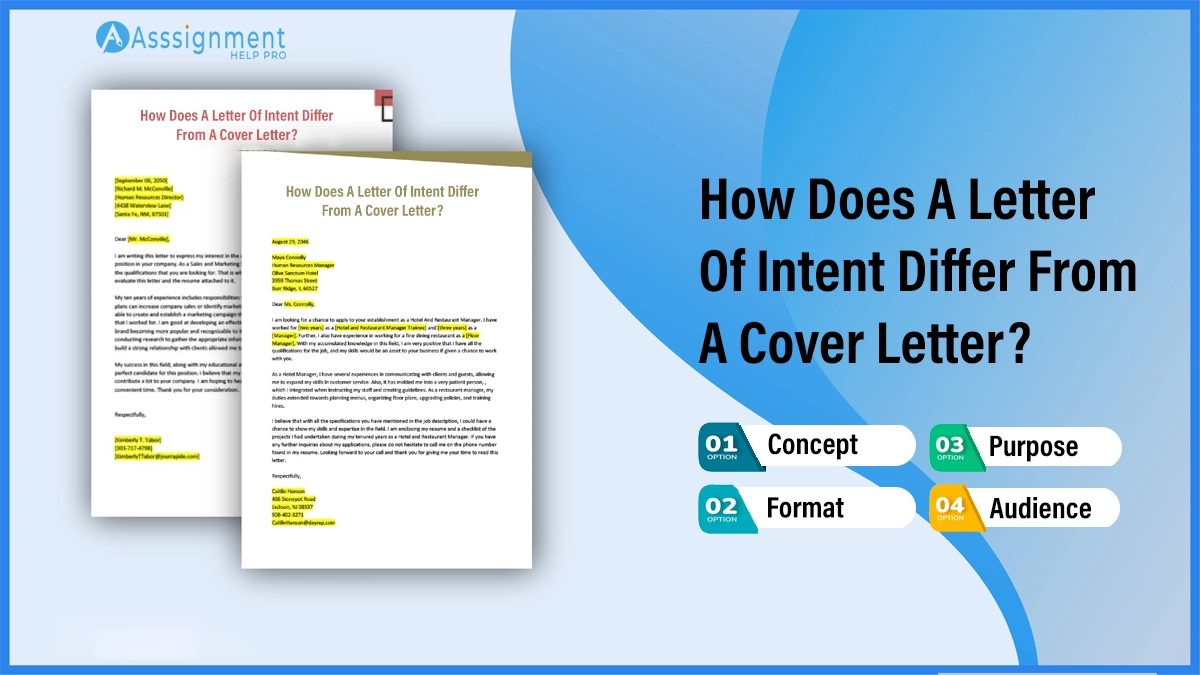If you are applying for a grant, business partnership, or academic program, then you must know how to write a letter of intent. Generally, in this letter, you should outline your goals and intentions and showcase your strengths and interests. A well-written letter of intent will make a strong impression and increase your chances of success.
A letter of intent and a cover letter are quite similar, yet they are different in every sense. Similar to a cover letter, a letter of intent is a broad overview of your industry-specific skills and knowledge. It also includes the reasons why you are fascinated by working for a specific employer. Moreover, this form of a letter, also known as a letter of intent, centers on the organization more than your skills. Nonetheless, if you are hunting for a job and need help with writing a letter of intent, this blog can be of great help to you. Here, you can clarify the meaning of a letter of intent, learn how to write a letter of intent, and familiarize yourself with its concepts. Moreover, to avoid your confusion with a cover letter, we have elucidated the common differences between a letter of intent and a cover letter.
What is a Letter of Intent?
A letter of intent is an introductory letter that you send to your employers stating your interest in working in the organization or with the employer. Typically, you address a letter of intent to hiring managers or recruiters at a company that has not posted jobs pertinent to your background. From the outside, it looks similar to a cover letter. But the contents detail less on the job role and more on self-introduction. For example, you can talk about your interest in working at an organization, the reason you find working with the company, and the experiences and skills that you possess that might be valuable to the organization, etc

How Does a Letter of Intent Differ from a Cover Letter?
If you ask your friends how to write a letter of intent, they might confuse you with the contents and purpose of a cover letter. Therefore, before you begin writing a letter of intent, you must increase your knowledge of the difference between the two. A letter of intent and a cover letter differ primarily in 4 aspects –
1. Concept
- Cover letter – They are built for pursuing individual jobs
- Letter of intent – Intent letters are for pursuing jobs at companies that attract you in general
2. Purpose
- Cover letter – Here, you introduce yourself and highlight your qualifications for a specific job opening
- Letter of intent –You use this correspondence to express your interest in pursuing a specific job opportunity
3. Format
- Cover letter – This type of letter is tailored to meet specific job openings and highlights the pertinent skills and knowledge
- Letter of intent – An intent letter is a long and detailed writing. You must give a comprehensive overview of your background, purpose, and qualifications.
Audience
- Cover letter – It addresses a specific individual, for example, a hiring manager.
- Letter of intent – You may address a broader audience through this letter, like a company as a whole.
The table below highlights the differences in detail
| Aspects of Difference | Cover Letter | Letter of Intent |
| Concept | You write them for pursuing individual jobs | Intent letters are for pursuing companies that attract you in general |
| Purpose | Here, you introduce yourself and highlight your qualifications for a specific job opening | You can take the help of this letter to express your interest in pursuing a specific job opportunity |
| Format | This type of letter is tailored to meet specific job openings and focuses on the pertinent skills and knowledge | An intent letter is a longer and more detailed writing. You must give a comprehensive overview of your background, purpose, and qualifications.
|
| Audience | It addresses a specific individual, for example, a hiring manager. | You may address a broader audience through this letter, like a company as a whole. |
Also read: Interesting Opinion Essay Topics for Academic Writing
Letter of Intent –When Should You Use It?
Learn how to write a letter of intent and use it in the following situations:
- For presenting resumes to a recruiter at a job fair.
- While researching companies, a specific employer catches your attention, who you believe best fits your interests and professional goals.
- You have heard or someone has let you know that an employer is hiring for a specific role. However, the company has not posted any advertisement for the recruitment of the specific job role.
- The employer has posted advertisements for job recruitment for other positions. But, they are also employing people in your area of expertise.
What to Include in a Letter of Intent?
You might wonder how to write a letter of intent when every letter is unique on its own. Well, everybody indeed has unique skill sets, experiences, and qualities. So, no intent letter is a replica of the other. But the 5 elements of a letter of intent remain the same. Hence, when you want to draft a letter, keep in mind to include the following elements in your copy:
1. Greetings or salutation
Greetings or salutations in a letter of intent follow a professional greeting format. Here, you may follow a standard greeting procedure like “Dear Hiring Manager,” or write the mail specifically to the individual hiring manager within the company. In that case, you may use a salutation such as “Dear Sir / Madam / [Name and surname of the hiring manager]”. However, if you are unsure of whom to address your letter, choose a more general greeting such as “Hello.”
Nonetheless, even if you know the hirer personally, never use informal or familiar greetings like “Hey” or include only the addressee’s first name. You’d best keep them safe for informal letters only, when you want to mail your friends and family. Because you primarily intend your letter to offer a positive and professional first impression that might lead to hiring opportunities.
2. Introduction
Introduce yourself formally to the recruiter in the first one or two sentences of your letter. Write your name, explain your background and current experience in the industry, and the purpose of writing the email. For example, if you are a fresher graduate, you can highlight your degree, area of study, and what you learned from it in the first few lines.
Contrastingly, if you are employed by any organization and are currently hunting for a job, you may share the following information:
- Share the title of your job,
- Draw attention to your work responsibilities,
- Explain your reason for seeking work opportunities in a different organization
- State what you find interesting in the company you are applying for a job.
However, never include any negative information in your intent letter. Talk about the positive reasons like advancement in career, scope to work in a different job role, etc.
3. Body
Use the body of your letter to explain your skills and experiences. Use this section as a scope to detail the reasons you can be a valuable member of the organization and what contributions you can make to the enhancement of your organization. However, never spend more than two paragraphs writing on it. Explain your qualities with specific examples of various situations when you achieved a goal or contributed to a company’s success in some way.
Moreover, put a figure on your accomplishment with numbers whenever feasible. Also, when you express your interest in a job role to an employer, try to emphasize how your skills and experiences make a parallel with the employer’s vision of the company’s future and its present needs.
4. Call to action
A call to action appears in the last paragraph of your letter of intent. Employ it to explain what you want the employer to do or take action after reading your letter. For example, you might bring this space into play to thank the employer for taking the time out of his schedule to read your letter.
Moreover, hint that you are always available if they want to contact you about prospective job opportunities. Including your contact information along with your signature will be a safe bet. It will highlight your eagerness to get the job.
5. Closing
Follow the standard business letter signing-off procedure to close your letter of intent. For example, you may simply choose to close the letter with “Sincerely,” or “Thank you.” Similarly, just like the introduction, you must best avoid being informal with the hiring officer here. So, stay away from friendly sign-offs such as “Cheers” or “Yours truly” in this section of your letter.
Read More: Basic Literary Devices Every Writer Should Know
Letter of Intent – Example
Below is an example letter of intent making use of the template above. Use this sample as a foundation for your letter of intent:
To Whom It May Concern,
My name is Jenifer Woo. I’m a fresher college graduate from the University of Dallas with a Bachelor of Arts in Journalism. WritersPress has a truthfully remarkable portfolio of work with a praiseworthy mission to inspire all people, no matter their background. Please consider my request for employment on your writing team.
During my time at Oak Ground Institution, I learned various aspects of journalism and copywriting. It includes APA style editing, extended- and short-form web content, editorial column writing, and human interest writing. I also gained knowledge through programs on content marketing. It includes search engine optimization and search engine marketing.
I finished all coursework with a 3.85 GPA. While pursuing my undergraduate studies, I was also a staff writer and worked for the College’s student newspaper. Additionally, I interned with several regional newspapers as a copywriter. Moreover, I used my free time to I also earned money as a freelance writer by writing several blogs on varied subjects.
As WritersPress, Inc. spotlights profoundly on high-quality web content, I consider that my skills and experience can make me an essential part of the team. If WritersPress, Inc. is in the market, looking for new copywriters, please consider me for any entry-level writing position that may become available. I’m also attaching my resume, which has more particulars regarding my skills, experiences, and interests.
Thank you for taking out time to read my letter.
Yours sincerely,
Jenna Woo
Email Letter of Intent Example
Below is another sample letter of intent using the best practices above, but formatted for email.
Subject: Introduction – Jenna Woo
Dear Ms. Smith,
During my 10-year term in sales and management for Product Life Inc., I have always been impressed with your company’s excellent sales record and reputation for exemplary customer service. I believe my expertise and sales knowledge can make me a helpful asset to Green Atmosphere as your next sales manager.
In the past year, single-handedly as sales manager for Product Life Inc., I have developed a new sales team and enhanced sales by more than 17%. In my previous role as sales team lead, I supervised the day-to-day activities of a 35-member sales team, where we employed data to institute clear goals and objectives. I present coaching and training to cultivate a high-performance team. I also produced a comprehensive training manual to reduce the recruitment process from 90 days to two weeks.
I’m a great equivalent for Green Atmosphere since I am both data-driven and client-focused. I’m fervent about encouraging employees to attain sales goals, and I am accomplished at recognizing actionable insight with data to steer customer loyalty and offer exceptional customer care.
I have affixed my resume to this email for you to evaluate. Thank you for your consideration—I am keyed up to find out more about this opportunity from you.
Sincerely,
Jenna Woo
jennawoo@email.com
(275) 969-7892
Read more: Interesting Microeconomics Research Paper Topics
Tips For Writing a Letter of Intent
You can never say that there is just one path to writing a letter of intent. The truth is, you may have 100 ways open, but you must be careful in choosing the right path to develop your letter of intent that will help in showcasing your candidature accurately. Here are a few best practices.
v Stick to a professional writing format
Adhere to a professional business letter format. If you mail a physical replica of the letter, never forget to include your name, email, and job title in the heading.
v Add contact information
If you intend to email the letter, state your contact information with your signature. Place it under your first and last name.
v Include a clear subject line
When you send an email, include a noticeable subject line that details the reason for sending your email.
v Include your name and job title
If you are applying for a specific job, incorporate your name and the job title. However, for cold calling, state your name and a phrase, such as “Job Inquiry” or “Data Analysis Specialist Looking to Share Expertise.”
v Research on the company
Before you write a letter of intent, ensure to study the company to get a good judgment of its culture, mission, and needs.
v Concentrate on your needs
Focus on what you need from the company and how the potential employer can benefit from your input.
v Mention the specific job role
To send the letter of intent, considering career advancement opportunities in mind, give an account of the level at which you want to be hired. Use precise language, such as “senior-level positions” or “management.”
v Never discuss salary
Do not discuss the salary range in your letter of intent. Wait to talk about it in your future email or after a successful interview.
Also read: Learn the Essential Literary Techniques to Improve Your Writing
v Mention the recommender’s name if necessary
Only mention the name of a friend or previous colleague who also works at the company you contact as a reference. However, avoid it if you have never mentioned it to the employer, or your friend and previous colleague have never mentioned your name to the hiring manager.
v Exercise only the active voice
Use active voice to denote your skills and experiences; “Strong communicator” or “Experienced writer” are common examples.
v Mention your skills and experience
Talk about your proficiency and experience relevant to the employer. Refer back to comparable job descriptions for skills the manager might be looking for.
v Keep it short
Make your letter of intent short, no more than a page, and uncomplicated.
v Proofread
Proofread and edit your letter before mailing the final copy.
Conclusion
Discussed here was a comprehensive guide on how to write a letter of intent. By now, you would have gained an idea about the concept of a letter of intent, when to use it, how to write it, and what tips you must follow to create a flawless copy. However, if you lack the writing skills to develop a compelling letter of intent or need help with writing it, connect with our experts immediately. By taking our expert assignment help online, you can compose a great letter of intent as per the standard format.




